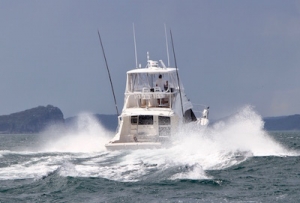Pairing the Length of your Trip with the Right Yacht
Cruising the world is a dream for many, and there’s no better way to do it than in your own yacht. When it comes to the question of how far yachts can travel, there’s no one set answer for this. There are so many different types of yachts, all designed for travel ranging from open ocean exploration to island hopping.
Really, there’s no limit to how far or how long a yacht can travel, if it’s suited to the trip you have in mind. The success of your trip will depend on how well your goals mesh with the category of yacht. It will also depend on whether you’re captaining a sailing or motor yacht, how often you need to stop to refuel or restock supplies and what forms of auxiliary power are used aboard. Whether your goal is to yacht around the world or explore the coastline closer to home, there is a yacht designed for the voyage you envision.
To Determine How Far a Yacht Will Be Able to Travel, Ask:
- Is it a sailing yacht or motor yacht?
- What type of yacht?
- How large is the yacht?
- How large is the fuel tank?
Sailing Yacht
A sailing yacht will take you anywhere you want to go. With a capable skipper, a seaworthy, well-maintained yacht and the right sailing conditions, you can see the whole world. A fully stocked, seaworthy 30-foot sailing yacht will sail about 100 nautical miles in a day, and she can continue up to 90 days without needing to stop. Given the right wind conditions, a sailing yacht in good shape can sail around the clock at a steady pace of about 5 knots per hour. A longer yacht with a larger hull will have a faster average speed and cover more distance than a smaller vessel.
Motorized Yacht
It gets more complicated with motorized yachts since they rely heavily on a fuel source. If your parameters are how far a motorized yacht can go on a single tank of gas, this depends on the size of the boat and the fuel tank.
The general rule is the bigger the vessel, the larger the fuel tank. For instance, a 75-foot motorized vessel that can carry 11,000 litres of fuel can travel about 1500 nautical miles, depending on conditions, whereas a 35-45 foot motorized yacht with a 100-litre tank can travel about 400 nautical miles.
However, a larger fuel tank doesn’t necessarily mean you’ll get that much further, since a larger boat would typically weigh more, have a larger crew, have more items contained inside and have more equipment—just to name a few variables.
Follow These Steps to Determine How Far Your Yacht Will be Able to Travel on A Single Tank of Fuel:
- Clean your yacht, make sure that everything is working correctly. A maintained yacht will have better fuel economy.
- Refuel your boat and always log engine hours as well as the times when you stop and start. This will narrow down how fast you go through fuel.
- Measure in litres or gallons per hour rather than relying on your fuel gauge, which doesn’t always account for conditions on the water.
What Type of Auxiliary Power Sources Does the Yacht Have?
Other than the fuel tank, yachts can run on wind, sun, and water power, options that can power amenities on board the yacht and push it that much further on its voyage in between fuelings. Options for alternative power sources include:
- Solar generators – Solar panels charge the boat’s batteries and hold a charge for when backup power is used. Some solar panels on the market today are so thin and flexible that they can be fixed onto or incorporated right into the sails
- Wind generators – Not just for sailing yachts, wind generators harness the power of the wind to charge the yacht’s batteries
- Hydro generators – Like upside down wind generators, hydro (water) generators are fixed to the transom and can be used to run systems on board, ranging from lights to water heaters
- Outboard motors – Useful on smaller vessels, outboard motors can be used as a backup if the on-board engine should ever experience technical problems
Categories of Yachts
There are four main categories of yachts. It’s important to know which category your yacht falls into in order to plan and prepare for your trip.
Category A
Also known as Explorer or Expedition Yachts, Category A yachts are crewed and designed for open ocean. They have a large hull that can handle waves up to 23 feet high. These yachts can also handle extraordinarily strong winds, up to 47 knots.
Category B
These yachts are also worthy of the wider seas but are not capable of crossing oceans and are less capable of strong winds and rough water. They can handle waves up to 13 feet high.
Category C
Used inshore, Category C yachts are ideal for larger bays and lakes. They can handle waves up to about 7 feet high.
Category D
Great for sheltered areas like lakes, protected harbours and rivers, these are vessels meant for day trips. Category D yachts can travel in areas with waves reaching under 4 feet high.
At Van Isle Marina, we have many new and used yachts suited to whatever trip you desire – from a week spent cruising just off the coast of Vancouver Island, to a full tour of the Atlantic Ocean.



